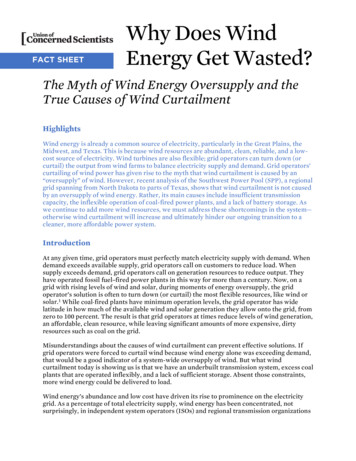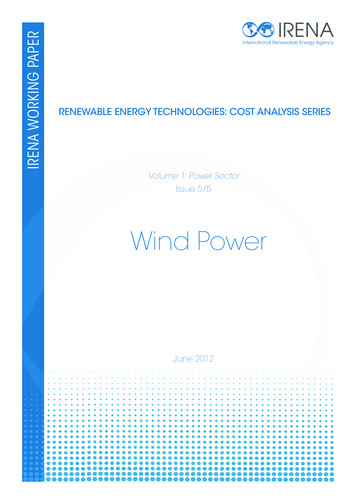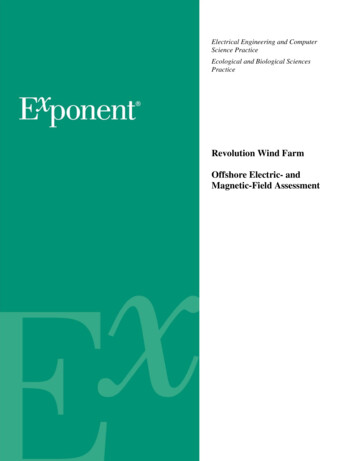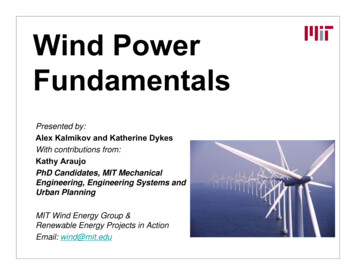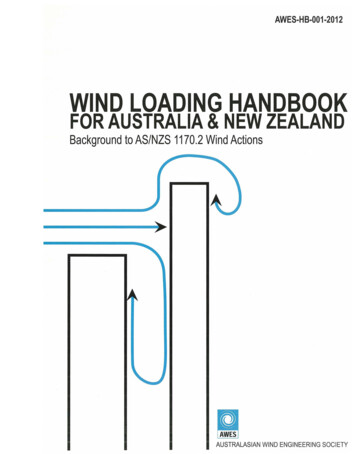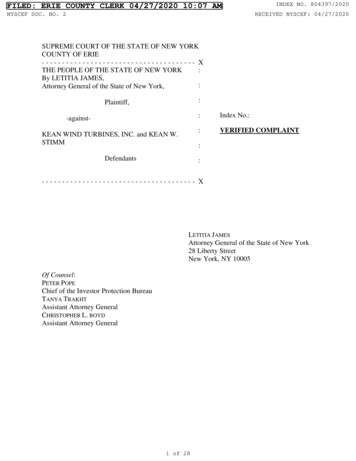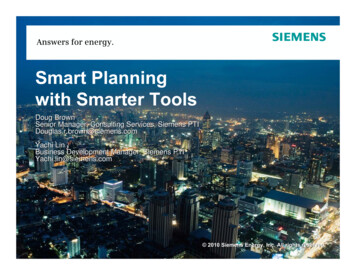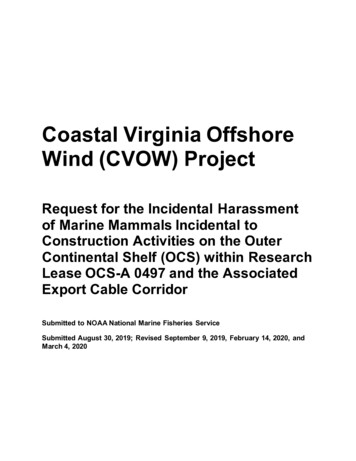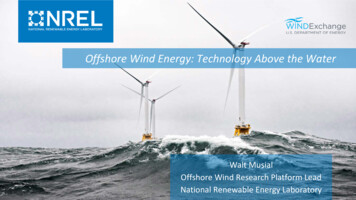
Transcription
Offshore Wind Energy: Technology Above the WaterWalt MusialOffshore Wind Research Platform LeadNational Renewable Energy Laboratory
Webinar Logistics Webinar will be recordedand posted to NRELYouTube channel andWINDExchange. Q&A following thepresentation. Put questions in the Q&Aduring and at the end of thepresentation.Photo by Gary Norton, DOE 41165NREL 2
Speaker BioMr. Walt MusialPrincipal EngineerOffshore Wind Research Platform LeadNational Renewable Energy LaboratoryGolden Colorado, USAWalt Musial is a Principal Engineer and leads the offshore wind researchplatform at the National Renewable Energy Laboratory (NREL) where he hasworked for 33 years. In 2003 he initiated the offshore wind energy researchprogram at NREL which focuses on a wide range of industry needs and criticaltechnology challenges. He chairs the American Clean Power AssociationOffshore Wind Standards Subcommittee and is the Senior Technical Advisor tothe National Offshore Wind R&D Consortium. Previously, Walt also developedand ran NREL’s full scale blade and drivetrain testing facilities for 15 years.Earlier, Walt worked as a test engineer for five years in the commercial windenergy industry in California. He studied Mechanical Engineering at theUniversity of Massachusetts - Amherst, where he earned his bachelor’s andmaster’s degrees, specializing in energy conversion with a focus on windenergy engineering. He has over 120 publications and two patents.NREL 3
What Will We Cover? Introduction to offshore wind energy Part 1: understanding the windresource including:– Wind resource characteristics– Technology implications Part 2: turbine technologyPhoto by Dennis Schroeder, NationalRenewable Energy Laboratory (NREL) 40463NREL 4
Introduction to Offshore Wind Energy
Why Pursue Offshore Wind Energy? Generation close toload (80% of the populationlives near the coast) Stronger winds Larger-scale projects arepossible Unique economic benefits Revitalizes ports anddomestic manufacturing Less constrained bytransport and constructionGraphic from National Renewable Energy Laboratory (NREL)NREL 6
Offshore Wind – Global Industry StatusPhoto from Siemens, 27892 At the end of 2020, over 200 projects were installed with acapacity of more than 33,000 megawatts (MW). The average project size is getting larger, with some wind powerplants exceeding 1,000 MW. Over 99% of offshore wind turbines are on fixed-bottom supportstructures in shallow water (less than 50 meters (m) depth). Average turbine rating is currently about 10 MW but will increaseto 12 to 15 MW for projects after 2024. Rotors are oriented upwind with 170-m diameters, growing to 220m to 240 m this decade. Tower heights increase with blade length (rule of thumb is towerheight blade length plus 30 m). Drivetrains are direct drive or geared with medium-speedgenerators. Overall costs are declining but maintenance costs will remainhigher than land-based turbines because of difficult access. Offshore wind energy leverages existing mature marineindustries.
Biden Administration Offshore Wind GoalsIn March 2021, the Biden administrationannounced the following series ofcoordinated steps to support increasedoffshore wind energy deployment: Set national target to reach 30 gigawattsby 2030 Advance U.S. wind energy projects tocreate well-paying, unionized jobs Invest in American infrastructure tostrengthen the domestic supply chain Support critical research anddevelopment and data sharing.Source: The White House Offshore Wind AnnouncementPhoto from Siemens, 27852NREL 8
Above the Water: UnderstandingWind Resource Characteristics andTechnology Implications
Summary: Understanding Wind Characteristics Wind Resource Assessment– Computer modeling technology– Measuring wind using floating lidar ormeteorological towers Wind Characteristics–––––Annual average wind speedWind speed probabilityWind direction (wind rose)Diurnal (daily) and seasonal variationsWind shear Wind Resource Data Access– Wind resource mapping– How to find and use dataPhoto by Gary Norton, DOE 41170NREL 10
Estimating the Wind Resource PotentialComputer Models The mesoscale Weather Research and Forecastingmodel (WRF) is used to estimate wind speed overvarious geographic areas and time intervals. Models calculate data every 5 minutes and everylocation on 2-kilometer-by-2-kilometer squares.NREL is developing The Wind Toolkit Long-termEnsemble Dataset for wind characterization at alltime scales.NREL/Rutgers collaboration: multiple ensembles of WRF generated wind speed data at100 m, plotted over a 6-day period at National Data Buoy Center Buoy 44025 off thecoast of New Jersey (m/s meters per second).Measurements Measurements are used to validate and improvethe accuracy of the models. Measurements at sea can be very difficult andexpensive. Validation is needed to reduce model uncertainty.Offshore wind measurements come from ocean buoys, floatinglidar* (left) or meteorological towers (right). Photo courtesy of NREL 11AXYS Technologies, 35605
Wind Resource StatisticsAt a given site:Wind Rose (top) and probability distribution for the Humboldt Call Area inCalifornia (bottom) Wind speed varies by the hour of theday, seasonally, and annually. Annual wind speeds are represented byprobability distributions (bottom left). Wind direction variations arerepresented by a wind rose (upper left). Other important variables includeturbulence intensity, atmosphericstability, and wind shear. All these characteristics affect energyproduction—but wind speed is the mostimportant.Beiter, Philipp, Walt Musial, Patrick Duffy, Aubryn Cooperman, Matt Shields, Donna Heimiller, and Mike Optis. 2020b. The Cost of Floating Offshore Wind Energy in California Between 2019 and 2032 . Golde n, CO: Na tiona lNRELRe ne wa ble Ene rgy La bora tory. NREL/TP -5000-77384. https ://www.nre l.gov/docs /fy21os ti/77384.pdf. 12
Diurnal and SeasonalVariationsFive sites along the coast of Oregon were analyzed fordiurnal and seasonal variations Wind speed varies over the course of a day (seeaverage diurnal variations for July in upper left). It is important to understand how wind variesduring the day so its energy potential can bematched with the electricity use. Seasonal variations also needed to be matchedwith electricity use (e.g., air conditioners, electricheating; see monthly variations in lower left). Use patterns will change drastically with gridexpansion and electrification (e.g., electric vehiclecharging, electrification, energy storage). Variations are site-specific.Musial, Walter D, Beiter, Philipp C, Nunemaker, Jacob, Heimiller, Donna M, Ahmann, Josh, and Busch, Jason. 2019. OregonOffshore Wind Site Feasibility and Cost Study. Golde n, CO: Na tiona l Re ne wa ble Ene rgy La bora tory (NREL). NREL/TP -5000NREL74597. https ://www.nre l.gov/docs /fy20os ti/74597.pdf. 13
Wind Speed Increases With Elevation Wind speed increases withheight (wind shear). It is important to know thewind speed at hub height. As wind turbines get larger,tower height increases. Taller wind turbinesgenerate more electricity.Graphic by Walt Musial, NRELWind speed measurements must be made at hub height for accurate energy prediction.NREL 14
Wind Resource Mapping and DataExample: 100-m mean wind speed map for California Offshore wind speeds for a region are bestdescribed by “heat maps” that show thevariations in average wind speedgeographically. The map shown (left) describes the windresource (CA20) at an elevation of 100 m. For offshore wind resource assessments, siteswith average wind speeds greater than 7meters per second (m/s) are consideredpotentially viable. Note the Humboldt Call Area shown earlier is arelatively high-wind site. Current wind resource data can be found onGithub and Wind Prospector.Optis, Michael, Rybchuk, Oleksa, Bodini, Nicola, Rossol, Michael, and Musial, Walter. 2020. 2020 Offshore WindResource Assessment for the California Pacific Outer Continental Shelf . Golde n, CO: Na tiona l Re ne wa ble Ene rgyNRELLa bora tory (NREL), NREL/TP -5000-77642. https ://www.nre l.gov/docs /fy21os ti/77642.pdf. 15
Extreme Weather Considerations:Performance and Technology Implications Weather extremes can affect both thereliability of wind turbines and theirenergy production. Offshore wind farms must be designedto withstand extreme weather including:–––––HurricanesExtreme wind/wave eventsIcy conditionsExtra tropical stormsExtreme heat or cold Climate change may affect thefrequency and severity of these weatherevents and must be accounted for inplanning, siting, and operations.Hurricane Maria Heads for Puerto RicoImage courtesy of National Aeronautics and Space Administration/National Oceanic andAtmospheric Administration GOES ProjectNREL 16
Above the Water: Wind Turbine Technology
Above-the-Water Parts ofan Offshore Wind TurbineTypically, offshore wind turbines differ fromland-based wind turbines in several ways.For example, they: Are bigger – In 2020, the averagecapacity of land-based turbines was 2.75MW, and the average capacity foroffshore turbines was 7.5 MW Have more complex support structures Are designed to withstand the marineenvironmentThe Siemens 2.3-MW offshore wind turbine in the Baltic Sea,Germany. Photo by Walt Musial (NREL)NREL 18
Offshore Wind Power Plant Basics The rotor (hub blades) convertskinetic energy of the wind to createtorque (rotational force) that spinsa generator that produceselectricity. Multiple turbines are connected toa substation that connects a highvoltage cable to the land-based grid. Offshore wind plants are growingbeyond 1,000 MW in size. Peak energy output is comparableto large coal, natural gas, or nuclearpower plants.Graphic by Joshua Bauer, NREL One 12-MW offshore wind turbinecan power 4,500 U.S. residences.NREL 19
Adapting Offshore Wind Plants for a Marine Environment Corrosion-resistant coatings, developed byoffshore oil and gas Pressurized nacelles keep the salt air out Designed for safety, accessibility, and crewtransfer Direct-drive and medium-speed generatorsto lower number of moving parts Specialized workforce training to operateand maintain the technology.Photo by Siemens, NREL 277866NREL 20
Offshore Wind Turbines Are Getting Bigger Larger turbines (12 MWto 15 MW) can reduceoffshore wind cost by:―Requiring fewer installations―Reducing the number ofturbines to maintain―Providing more energy(turbines can access higherwinds). There are no physicalbarriers to increasingturbine size. Ports and infrastructuremust also accommodatenew 12- to 15-MWturbines.Graphic by Joshua Bauer, NRELBy 2024, all major wind turbine manufacturers plan to beproducing turbines in the 12-MW to 15-MW range.NREL 21
The Wind Turbine Tower The wind turbine’s tower connects the nacelle tothe substructure. Offshore wind energy uses a “tube tower”; atapered steel tube that is 100 m or more inlength. Tube towers are used exclusively because they:―Protect workers and components from theelements―Reduce impact on avian species―Are easy to maintain.Photo by Walt Musial, NREL 26993 Tower cross sections have diameters of 5 m ormore. The inside of a wind turbine tower includes anelevator, ladders, and platforms as well asrouting for the power cables.Photos (bottom left and bottom right) by Mary Hallisey, NRELNREL 22
The NacelleThe nacelle comprises everything above the yaw bearing except the rotor. Drivetrain. The drivetrain is the mechanical pathwaythat converts rotor torque into electricity. It includesthe main bearing, main shaft, gearbox (if used), andgenerator. Gearbox. The gearbox increases the low-speed shaftrotational speed to spin the generator. Direct-driveoffshore wind turbines do not have gearboxes. Generator. The generator converts mechanicalenergy into electricity. Some generators are drivenby gearboxes and others are attached directly to thegenerator (direct-drive). Power Electronics. The power electronicsconditioned the power produced by the generator tobe sent to the grid.*Definitions adapted from DOE How a Wind Turbine Works - Text VersionDrivetrainPower ElectronicsGeneratorGraphic by Joshua Bauer, NRELNREL 23
The Yaw Drive System Yaw Drive System. The yawdrive rotates the nacelle tokeep a turbine facing into thewind when the wind directionchanges. Yaw Bearing. The yaw bearingsits on top of the tower toallow for rotation.Yaw Drive SystemGraphic by Joshua Bauer, NRELNREL 24
Outside the NacelleThe exterior of the nacellecomprises the following: Helidecko Service platform forhelicopters Sensorso Anemometers and winddirection control sensorso Temperature sensorso Accelerometerso Displacement sensorsGraphic by Joshua Bauer, NREL Aviation warning lights Composite nacelle enclosure.NREL 25
Rotor The rotor is the assemblycomprising three blades and thehub. The rotor assembly is attached tothe main shaft and drivetrain.RotorPhoto by Mary Hallisey, NREL The blades are mounted to thehub on turntable bearings thatallow for 90 degrees of rotation. Each blade has an independentpitch control system that pitchesthe blades to regulate power andto stop the machine.NREL 26
Wind Turbine Blades100 meters length7 meters lengthGraphic from NREL; based on a graphicfrom Kenneth Thomsen, formerlySiemens Gamesa Renewable EnergyPhoto from Walt Musial, NRELNREL 27
Offshore Wind Substation Offshore substations or electric serviceplatforms collect AC power from allturbines across a wind power plant at 66kilovolts (kV). High-voltage transformers step up thevoltage to 220 kV and export it to shorethrough buried subsea cables. Substations are attached to the seabedwith substructures (e.g., monopiles ormultileg jackets similar to oil rigs). Some offshore substations may havetemporary quarters for on-site personnel.Photo from Siemens, 27865NREL 28
Surface View of Floating and Fixed-Bottom Wind TurbinesPrinciple Power 2.0-MW floating wind turbine inPortugal; 2011WindFloat semisubmersible substructure.Photo by Walt Musial, NRELEquinor 6-MW Siemens floating wind turbine inScotland; 2017Hywind-2 spar substructure.Photo by Walt Musial, NRELBaltic-1 2.3-MW Siemens fixed-bottom windturbine in Germany; 2010monopile substructure.Photo by Walt MusialFloating and fixed-bottom offshore wind power plants use the same turbines, and above the water there can be little visual difference
Key Takeaways The global offshore wind energy industry is growing rapidly. The UnitedStates set a new target for offshore wind to achieve 30 gigawatts by 2030. Wind resource is determined by many factors including wind speed,direction, time of day, and season. Wind measurements are key toaccurate wind models. Offshore wind turbines require adaptation to endure marineenvironments. Offshore wind turbines are getting increasingly larger because biggerturbines are more economical. Wind energy technology above the water is similar in both fixed-bottomand floating turbines.NREL 30
Thank youQ&Afor your attention!Walt MusialOffshore Wind Research Platform LeadNational Renewable Energy Laboratorywalter.musial@nrel.govPhoto by Dennis Schroeder, NREL 40389NREL 31
Thank Youwww.nrel.govNREL/PR-5000-81227This work was authored by the National Renewable Energy Laboratory, operated by Alliance for Sustainable Energy,LLC, for the U.S. Department of Energy (DOE) under Contract No. DE-AC36-08GO28308. Funding provided by theU.S. Department of Energy Office of Energy Efficiency and Renewable Energy Wind Energy Technologies Office. Theviews expressed in the article do not necessarily represent the views of the DOE or the U.S. Government. The U.S.Government retains and the publisher, by accepting the article for publication, acknowledges that the U.S.Government retains a nonexclusive, paid-up, irrevocable, worldwide license to publish or reproduce the publishedform of this work, or allow others to do so, for U.S. Government purposes.
– Extreme wind/wave events – Icy conditions – Extra tropical storms – Extreme heat or cold Climate change may affect the frequency and severity of these weather events and must be accounted for in planning, siting, and operations. Image courtesy of National Aeronautics and S

